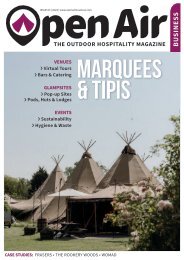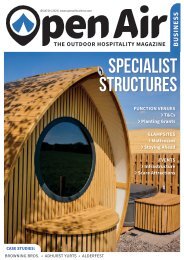Open Air Business November/December 2016
The UK's outdoor hospitality business magazine for function venues, glampsites and event organisers
The UK's outdoor hospitality business magazine for function venues, glampsites and event organisers
You also want an ePaper? Increase the reach of your titles
YUMPU automatically turns print PDFs into web optimized ePapers that Google loves.
INDUSTRY TALK<br />
green burials is increasing as<br />
space at traditional cemeteries<br />
becomes ever more limited. There<br />
are currently over 270 green burial<br />
sites in the UK, both in established<br />
and newly created woodland. The<br />
Arbory Trust site at Barton near<br />
Cambridge (www.arborytrust.<br />
org.uk) shows what is possible in<br />
newly created woodland.<br />
For more traditional farming<br />
businesses based on crops and/or<br />
livestock, integration of trees and<br />
woods into their farming systems<br />
can offer a range of benefits. Trees<br />
and woods can offer shade in the<br />
summer for livestock and shelter<br />
in the winter; summer heat stress<br />
can be a real problem for outdoor<br />
pigs and dairy cows.<br />
The issue with dairy cows was<br />
highlighted in SE Farmer magazine<br />
in July 2015 in the ‘Vet’s Diary’<br />
section: “10th July; We have<br />
seen a number of dairy cows<br />
experiencing heat stress, having a<br />
large impact on their productivity<br />
and increasing their risk for other<br />
diseases.”<br />
Winter cold and exposure can<br />
be a real hazard for field born<br />
lambs, especially in the first 48<br />
hours, but the experience of the<br />
Pontbren farmers in mid Wales<br />
has demonstrated how carefully<br />
constructed shelter in the form<br />
of woods, copses and hedges can<br />
reduce the scale of the problem.<br />
Studies have shown that in cold,<br />
wet and windy weather lamb<br />
losses can be reduced by up to<br />
30% if good shelter is provided.<br />
A somewhat more novel use<br />
of trees for dairy cows is being<br />
trialled by one of the Woodland<br />
Trust’s farming ambassadors;<br />
Tim Downes farms in Shropshire,<br />
milking 250 cows and supplying<br />
the Organic Milk Suppliers<br />
Co-operative. Working with the<br />
Woodland Trust and Harper<br />
Adams University, Tim has set up<br />
browsing trials to assess which<br />
tree species might help his cattle<br />
nutritionally as an alternative<br />
source of protein as well as<br />
medicinally, with species such<br />
as willow being rich in salicylic<br />
acid, which has anti-inflammatory<br />
properties.<br />
Tree shelter can also, perhaps<br />
more surprisingly, benefit arable<br />
crops. Trees can reduce wind<br />
speeds across fields, thereby<br />
cutting down evapo-transpiration<br />
ABOUT THE AUTHOR<br />
John Tucker is a<br />
chartered forester<br />
with 30 years<br />
experience in multipurpose<br />
woodland<br />
management. He<br />
has worked for the<br />
Woodland Trust for 20<br />
years and is currently<br />
director of Woodland<br />
Creation, with a<br />
particular focus on<br />
working with private<br />
landowners across<br />
the UK. See www.<br />
woodlandtrust.org.uk<br />
rates meaning that crops can<br />
use water more efficiently.<br />
Research in Canada has shown<br />
that shelterbelts can increase tree<br />
yields by 3.5% and that this figure<br />
can be even higher in drier years.<br />
The shelter offered by trees and<br />
woods can also benefit pollinating<br />
insects, with species such as Goat<br />
Willow flowering in January and<br />
offering a source of pollen and<br />
nectar when there is little else<br />
available.<br />
A farmer’s most precious<br />
resource is of course his soil and<br />
yet 2.9m tonnes are lost in the UK<br />
annually. This erosion can have<br />
a major negative impact on the<br />
water quality of our rivers and<br />
water courses. Carefully sited trees<br />
can militate against this erosion<br />
as well as soaking up pollutants,<br />
notably nitrates and phosphates.<br />
Tree roots improve filtration<br />
meaning water penetrates into the<br />
soil rather than simply running<br />
off. Research at Pontbren in<br />
Wales showed infiltration rates in<br />
recently created woodland were<br />
60 times higher than those in<br />
pasture only 10m away.<br />
BUILDING A BRAND<br />
Finally to branding; if you visit<br />
a Sainsbury’s supermarket you<br />
will see boxes of eggs featuring<br />
a picture of several chickens and<br />
some trees. This is the Sainsbury’s<br />
Woodland Egg range on which the<br />
Woodland Trust has partnered<br />
with the supermarket chain for<br />
more than 10 years.<br />
Sainsbury’s currently sells<br />
around 450m woodland eggs<br />
annually, a market that has grown<br />
by 108% over the past 10 years.<br />
The brand is obviously successful<br />
but what lies behind it is also<br />
very interesting. Chickens are<br />
woodland birds and free range<br />
hens are far more likely to range if<br />
they are in a treed rather than an<br />
open environment.<br />
Studies have shown that a more<br />
treed environment reduces the<br />
occurrence of ‘injurious feather<br />
pecking’ among the birds and<br />
research by the Lakes Free Range<br />
Egg Company has shown that<br />
chickens with tree cover produce<br />
eggs with better shell quality,<br />
which results in less ‘seconds’<br />
during collection and packing.<br />
Thus we have a win, win situation<br />
– birds with higher welfare<br />
producing a higher value product.<br />
Trees and woods may well offer<br />
more potential to support a new<br />
business venture than you first<br />
thought. As with any business<br />
development, good planning is<br />
essential. The Woodland Trust can<br />
advise on new tree and woodland<br />
planting and organisations such<br />
as the Institute of Chartered<br />
Foresters, the Royal Forestry<br />
Society and the Arboricultural<br />
Association may also be useful.<br />
USEFUL LINKS<br />
www.woodlandtrust.org.uk<br />
www.charteredforesters.org.uk<br />
www.royalforestrysociety.org.uk<br />
www.trees.org.uk<br />
10 WWW.OPENAIRBUSINESS.COM


















